Pages
1-12
Author: Sayka Banu, and Mohammad Tanvir Rahman
The effects of aggregate type, size, and content on the behaviour of concrete is evident. It is well recognized that coarse aggregate plays an important role in concrete. Coarse aggregate typically occupies over one-third of the volume of concrete, and research indicates that changes in coarse aggregate can change the strength and fracture properties of concrete. To predict the behaviour of concrete under general loading requires an understanding of the effects of aggregate type, aggregate size, and aggregate content. This understanding can only be gained through extensive testing and observation. There is controversy, however, on the effects of coarse aggregate content on the compressive strength of concrete and the conditions to achieve the strength. Keeping this in mind, this paper deals with the actual amount of materials needed to achieve a particular strength, and the conditions, which greatly affect the gaining of this strength, putting special emphasis on different material conditions. It also puts an effort to find out the potentiality of recycled brick chips concrete along with other aggregates through compressive strength against time with different parameters.
Pages
87-99
Author: Riana Tanzen, Jawad Mahmud Hoque and Md. Sultanul Islam
Mitigating the losses of human lives owing to highway crashes needs
better insights to the roadway locations as well as the performance
of various safety measures. All these require the analysis of existing
crash data for various roadway segments, both deemed “safe” and
“unsafe” with different safety measures installed. Statistical models
project the safety standards and their suitability into the future.
Various tools and modeling techniques or regression models,
primarily based on Poisson Regression, are employed to analyze
crash data. This paper discusses some common methodological
issues which are constraining the effectiveness of various existing
models, then assesses the strengths and weaknesses of these
models, followed by introducing more promising and advanced
approaches that predict results with much more accuracy than the
traditional statistical models.
Pages
124-133
Author: Md. Sultanul Islam and Sharmin Zaman
A study was conducted to investigate the impact of the wastewater
received from numerous sources along the Buriganga river through
present state of water quality and pollution level. The water samples
were collected from five different points namely Wise Ghat, Badamtoli
Ghat, Babubazar Ghat, Lalkuthi Ghat and Postogola Ghat during
monsoon from May to September in 2016 and analyzed for various
physicochemical parameters. The observed values of temperature,
pH, EC, DO, BOD, TDS and turbidity were spatially and temporally
varied from 27-34ºC, 6.02-7.79, 136-285 μS/cm, 0.6-2.4 mg/l, 6.7-20
mg/l, 68.2-145 mg/l and 13.06-52 NTU respectively. The result
showed that the river water was not suitable for aquatic organisms
living therein.

